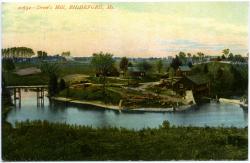
J.G. Deering & Son Lumber Co., Biddeford, ca. 1880
Maine Historical Society
By the mid to late 1700s Biddeford was a growing town, in the varied and successful industries growing up. It was a typical colonial American town, well placed along trade routes and a bustling hub. Lumber was one of the earliest and most successful industries in the area. The earliest logs were cut from around the falls. By the end of the 18th century the logs were being sent down from Fryeburg and points north. Before 1800 there were 17 sawmills around the falls, cutting an estimated 50,000 feet of boards every day. Most of these products were sold in Boston, Providence and New York City.

Drew's Mill, Biddeford, 1909
McArthur Public Library
Lumber and other goods from the interior came down the river where they were readied for sale throughout the colonies and abroad. Men and women built small farms along the fertile banks of the river, grew crops and raised livestock for themselves and to trade. The heart of the town was shifting from Winter Harbor up the river to Falls Village.
Prior to the building of the first bridge in 1758, the only way to cross the river was by ferry. The "lower ferry" was down by the mouth of the river, while the "upper ferry" was nearer the falls.

Engraving of James Sullivan, ca. 1800
Maine Historical Society
Professionals were drawn to the bustling town, and doctors and lawyers opened up successful, busy practices. James Sullivan was one of these lawyers, and would serve as a Judge in the Supreme Court, Governor of Massachusetts, and Biddeford's representative to the Provincial Congress prior to the Revolution.
Biddeford was a solidly Whig town, and Tory residents didn‘t remain in town long. The citizens of Biddeford proclaimed their support of the Revolution on 30 July 1774, and sent representatives to the Provincial Congress as a result. Many of the able-bodied men of the town served in the war, either close to home or elsewhere in the Colonies.

Fort Hill, Biddeford, ca. 1906
McArthur Public Library
An example of this were Captain Benjamin Hooper and his sea coast patrol company "to Defend the Sea Coast in the Colony of the Massachusetts Bay", raised at Biddeford and Pepperellborough (Saco). The company served as a patrol along the coast for the towns of Biddeford, Pepperellborough, and Arundel (Kennebunkport) and served from July 17, 1775 to December 31 of that same year. The company led by Captain Hooper included 1st Lieut. Humphrey Pike, 2nd Lieut. John Lord, 4 Sergeants, 4 Corporals, 1 Drummer, 1 Fifer, and 36 Privates.